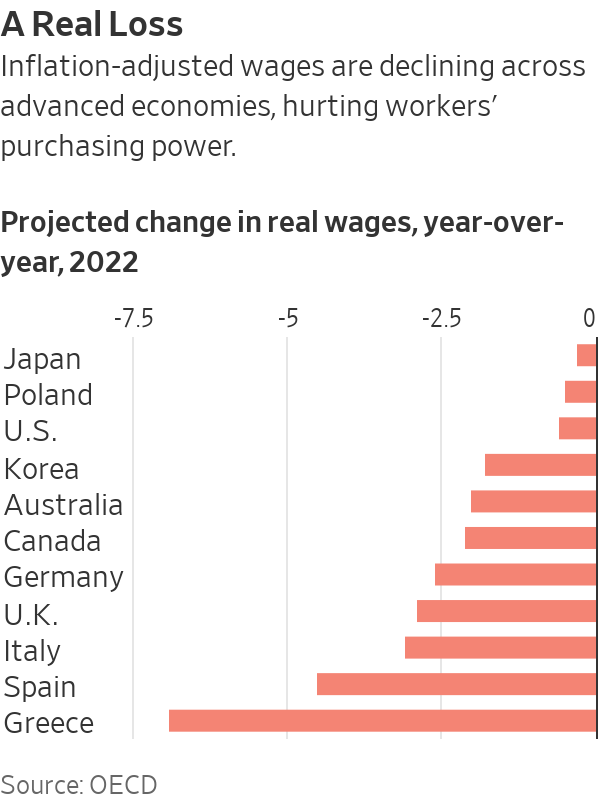Workers’ Pay Globally Hasn’t Kept Up With Inflation
Decline in purchasing power could reverse this year if prices rise more slowly
Wage growth across advanced economies is plateauing or declining from high levels. For central banks, it is good news: There are no signs of a spiral in which wages push up prices, which push up wages again. That makes it more likely inflation could decline without a significant increase in unemployment.
For workers, though, it is less positive. Wages rose faster last year than in the previous two years, but not as much as prices across major advanced economies, according to projections by the International Labour Organization. Workers’ purchasing power—their average inflation-adjusted wage—was lower last year than in 2019, before the pandemic, according to the report. So despite strong demand for workers and ultralow unemployment, labor’s share of economic output shrank in many advanced economies.
In the U.S., nominal wage growth—meaning unadjusted for inflation—has slowed sharply since the middle of last year, according to a variety of measures. Average hourly earnings for private-sector nonfarm workers rose 4.4% in the 12 months through January, down from 5.6% last March and less than the 6.4% rise in consumer prices in the year through January.

In Europe, average wage growth across six countries declined to 4.9% in December from 5.2% in November, according to a report by Ireland’s central bank and the recruitment company Indeed, which tracks advertised wages across millions of online job ads. Inflation in the eurozone ended the year at 9.2%.
In Canada, central bank chief Tiff Macklem highlighted easing wage growth to explain the bank’s recent decision to pause interest-rate increases after raising its key rate to 4.5%, the highest level in 15 years.
“Wage growth is currently running between 4% and 5% and appears to have plateaued within that range… The risk of a wage-price spiral has diminished,” Mr. Macklem said.
Economists have noted that pay growth tends to lag, not lead, inflation as workers and employers adjust pay expectations to the prices they have experienced. Thus, the recent decline in pay growth might reflect, with a lag, the fact inflation peaked around summer and fall of last year in major economies like the U.S. and eurozone and has since declined, as energy prices fell sharply and global supply-chain pressures eased.
Why, though, did wages never catch up with inflation in the first place? One reason is that wages tend to be sticky, changing relatively slowly and sluggishly—over months and years—while prices can change more rapidly. Firms might be wary of raising wages aggressively since cutting them later would be bad for morale.
Now, slowing economic growth and the threat of layoffs might be tempering workers’ demands, said Andrea Garnero, an economist with the Organization for Economic Cooperation and Development. Labor unions in Europe have grown more concerned about job security than wages, he said.
Workers’ pay demands have been reasonable in part because their incomes were supported by government aid during the pandemic and energy crisis, said Gabriel Makhlouf, governor of Ireland’s central bank. “People understand that they can make things worse if they require the wrong [pay] deal,” he said in an interview.
Crucially, the number of workers, which shrank in the first months of the pandemic, is rebounding in many advanced economies, helping to ease shortages.
Some workers who left the labor force during the pandemic are being tempted back as pandemic savings dwindle and are eroded by inflation. Almost 83% of Americans ages 25-54 are working or actively looking for work, roughly back to the pre pandemic rate, according to the U.S. Labor Department. About 86.5% of Europeans ages 25-54 have jobs or are actively searching, 1 percentage point above prepandemic levels. The U.K. stands out for a decline in its labor-force participation coupled with unusually strong wage growth, suggesting that a shortage of workers could be driving pay higher.
Immigration has also rebounded strongly in recent months, hitting record levels in Canada, Spain and Germany as some governments try to make up for shortfalls during the pandemic.
In the U.S., net international migration added more than a million people to the population in the year through mid-2022, the Census Bureau said. Migrant workers could have helped fuel January’s robust 517,000 increase in nonfarm payrolls while keeping wage inflation moderate, said Torsten Slok, chief economist at Apollo Global Management. The same forces could be at play in Europe, he said.
History suggests that workers often fail to claw back losses from high inflation. In the U.S., periods of high inflation were, in general, periods of lower real-wage growth, according to research by the Federal Reserve Bank of St. Louis. High inflation in Australia in the 1970s and 1980s led to real income losses for workers, according to the country’s central bank.
But there are reasons to think real wages might recover soon. Wage growth remains around its fastest in at least a decade across a range of advanced economies. It could stay elevated as wage bargaining proceeds.
Absent a deep recession, unemployment could stay low enough to preserve some bargaining power for workers. The labor supply is being constrained by aging populations across advanced economies and increased worker absences due to illness, often Covid-19.
And markets are betting inflation will fall rapidly this year across advanced economies. If so, it could well fall below wage growth, so real wages would rise—along with workers’ share of the economic pie.
 Copyright 2020, Dow Jones & Company, Inc. All Rights Reserved Worldwide. LEARN MORE
Copyright 2020, Dow Jones & Company, Inc. All Rights Reserved Worldwide. LEARN MORE
This stylish family home combines a classic palette and finishes with a flexible floorplan
Just 55 minutes from Sydney, make this your creative getaway located in the majestic Hawkesbury region.
Impact investing is becoming more mainstream as larger, institutional asset owners drive more money into the sector, according to the nonprofit Global Impact Investing Network in New York.
In the GIIN’s State of the Market 2024 report, published late last month, researchers found that assets allocated to impact-investing strategies by repeat survey responders grew by a compound annual growth rate (CAGR) of 14% over the last five years.
These 71 responders to both the 2019 and 2024 surveys saw their total impact assets under management grow to US$249 billion this year from US$129 billion five years ago.
Medium- and large-size investors were largely responsible for the strong impact returns: Medium-size investors posted a median CAGR of 11% a year over the five-year period, and large-size investors posted a median CAGR of 14% a year.
Interestingly, the CAGR of assets held by small investors dropped by a median of 14% a year.
“When we drill down behind the compound annual growth of the assets that are being allocated to impact investing, it’s largely those larger investors that are actually driving it,” says Dean Hand, the GIIN’s chief research officer.
Overall, the GIIN surveyed 305 investors with a combined US$490 billion under management from 39 countries. Nearly three-quarters of the responders were investment managers, while 10% were foundations, and 3% were family offices. Development finance institutions, institutional asset owners, and companies represented most of the rest.
The majority of impact strategies are executed through private-equity, but public debt and equity have been the fastest-growing asset classes over the past five years, the report said. Public debt is growing at a CAGR of 32%, and public equity is growing at a CAGR of 19%. That compares to a CAGR of 17% for private equity and 7% for private debt.
According to the GIIN, the rise in public impact assets is being driven by larger investors, likely institutions.
Private equity has traditionally served as an ideal way to execute impact strategies, as it allows investors to select vehicles specifically designed to create a positive social or environmental impact by, for example, providing loans to smallholder farmers in Africa or by supporting fledging renewable energy technologies.
Future Returns: Preqin expects managers to rely on family offices, private banks, and individual investors for growth in the next six years
But today, institutional investors are looking across their portfolios—encompassing both private and public assets—to achieve their impact goals.
“Institutional asset owners are saying, ‘In the interests of our ultimate beneficiaries, we probably need to start driving these strategies across our assets,’” Hand says. Instead of carving out a dedicated impact strategy, these investors are taking “a holistic portfolio approach.”
An institutional manager may want to address issues such as climate change, healthcare costs, and local economic growth so it can support a better quality of life for its beneficiaries.
To achieve these goals, the manager could invest across a range of private debt, private equity, and real estate.
But the public markets offer opportunities, too. Using public debt, a manager could, for example, invest in green bonds, regional bank bonds, or healthcare social bonds. In public equity, it could invest in green-power storage technologies, minority-focused real-estate trusts, and in pharmaceutical and medical-care company stocks with the aim of influencing them to lower the costs of care, according to an example the GIIN lays out in a separate report on institutional strategies.
Influencing companies to act in the best interests of society and the environment is increasingly being done through such shareholder advocacy, either directly through ownership in individual stocks or through fund vehicles.
“They’re trying to move their portfolio companies to actually solving some of the challenges that exist,” Hand says.
Although the rate of growth in public strategies for impact is brisk, among survey respondents investments in public debt totaled only 12% of assets and just 7% in public equity. Private equity, however, grabs 43% of these investors’ assets.
Within private equity, Hand also discerns more evidence of maturity in the impact sector. That’s because more impact-oriented asset owners invest in mature and growth-stage companies, which are favored by larger asset owners that have more substantial assets to put to work.
The GIIN State of the Market report also found that impact asset owners are largely happy with both the financial performance and impact results of their holdings.
About three-quarters of those surveyed were seeking risk-adjusted, market-rate returns, although foundations were an exception as 68% sought below-market returns, the report said. Overall, 86% reported their investments were performing in line or above their expectations—even when their targets were not met—and 90% said the same for their impact returns.
Private-equity posted the strongest results, returning 17% on average, although that was less than the 19% targeted return. By contrast, public equity returned 11%, above a 10% target.
The fact some asset classes over performed and others underperformed, shows that “normal economic forces are at play in the market,” Hand says.
Although investors are satisfied with their impact performance, they are still dealing with a fragmented approach for measuring it, the report said. “Despite this, over two-thirds of investors are incorporating impact criteria into their investment governance documents, signalling a significant shift toward formalising impact considerations in decision-making processes,” it said.
Also, more investors are getting third-party verification of their results, which strengthens their accountability in the market.
“The satisfaction with performance is nice to see,” Hand says. “But we do need to see more about what’s happening in terms of investors being able to actually track both the impact performance in real terms as well as the financial performance in real terms.”
This stylish family home combines a classic palette and finishes with a flexible floorplan
Just 55 minutes from Sydney, make this your creative getaway located in the majestic Hawkesbury region.






















